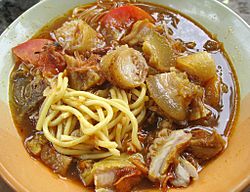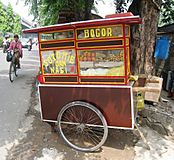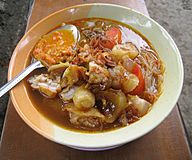Soto mie facts for kids

Soto mie bogor style, noodle and rice vermicelli, cabbage, tomato, (cartilage and tendons of cow's trotters) and tripes, risoles spring rolls, served in broth soup, added sweet soy sauce, sprinkled with fried shallots and sambal chilli.
|
|
| Alternative names | Soto mi, Mee soto |
|---|---|
| Course | Main course |
| Place of origin | Indonesia |
| Region or state | Nationwide in Indonesia, also popular in Maritime Southeast Asia |
| Associated national cuisine | Indonesia, Singapore, Malaysia |
| Serving temperature | Hot |
| Main ingredients | Chicken, or beef soups with noodle |
| 433 kcal (1813 kJ) | |
Soto mie, also known as Soto mi or Mee soto, is a delicious and spicy noodle soup. It's a popular dish in Indonesia, Malaysia, and Singapore. The name "mie" means noodle, usually made from flour, salt, and egg. "Soto" is a general term for many types of Indonesian soups. In Indonesia, people call it soto mie. But in Malaysia and Singapore, it's often known as mee soto.
Contents
What's in Soto Mie?
Soto mie can be made with different main ingredients. You might find it with beef or chicken. Sometimes, it uses offal, which are parts like cow's trotters (skin, cartilage, and tendons) or tripe. People can choose between noodles or thin rice vermicelli for their soup.
Common Ingredients
A bowl of soto mie usually has noodles or rice vermicelli. It also includes slices of fresh tomato and boiled potato. You'll often find hard-boiled egg, cabbage, peanuts, and bean sprouts. Then, beef, offal, or chicken meat is added. A warm, flavorful broth is poured over everything. This soup broth is made from beef or chicken stock. It's seasoned with many different spices.
Toppings and Sauces
You can add extra flavors to your soto mie. Common toppings include lime juice (jeruk nipis). Spicy chili sauce called sambal is also popular. Crispy fried shallots (bawang goreng) add a nice crunch. Some people like to add vinegar or sweet soy sauce (kecap manis). Another common topping is emping, which are crispy crackers.
Types of Soto Mie
There are two main types of soto mie. One uses beef, and the other uses chicken. The beef version is usually called soto mie. The chicken version is often called mee soto.
Soto Mie from Bogor and Jakarta
The most famous soto mie in Indonesia comes from Bogor, a city in West Java. It's a very popular street food. You can often find it sold by vendors with carts. These carts travel through business areas and neighborhoods.
Bogor Style Soto Mie
The beef broth for Bogor soto mie is very flavorful. It's spiced with ingredients like shallots and garlic. Other spices include candlenut, peppercorn, and dried shrimp. Bay leaves, lime leaves, and lemongrass are also used. A bit of lime juice adds a fresh taste. This dish uses beef or cow's trotters. It comes with noodles, fried spring rolls (called risole), tomato, cabbage, potato, and celery.
Jakarta Style Soto Mie
The Jakarta version of soto mie is very similar to the Bogor style. However, in Jakarta, beef meat is usually preferred over cow's trotters. The spice mix for the broth also includes galangal.
Mee Soto from Singapore and Johor
In Singapore and Johor, Malaysia, the most popular type is mee soto ayam. This means chicken noodle soto. It's a spicy noodle soup that mixes Indonesian chicken broth with thick yellow Hokkien noodles.
Chicken Broth for Mee Soto
The chicken broth for mee soto is made with a special spice paste. This paste includes ground peppercorns, coriander, and garlic. Other spices are candlenut, galangal, red onion, and turmeric. Bruised lemongrass, cardamom, cloves, and cinnamon also add to the flavor.
Origins of Mee Soto
Mee soto has roots in Javanese cooking. It's very popular in Singapore and Johor. It's quite similar to soto ayam (chicken soto) found in Indonesia. The main difference is that mee soto uses noodles instead of rice vermicelli. The soto ayam broth used for mee soto came from the Madurese people. They were immigrants from Surabaya, East Java, who settled in Johor and Singapore. They brought their spicy soto ayam dish with them. They simply swapped the rice dumplings (lontong) for yellow noodles.



